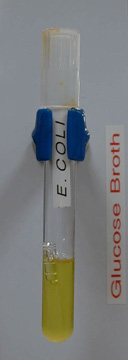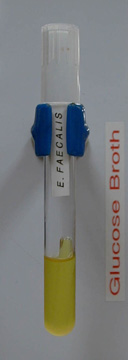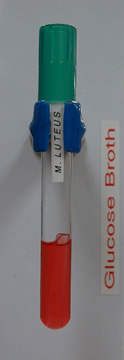Phenol Red Broth
Phenol Red Broth is a general-purpose differential test medium typically used to differentiate gram negative enteric bacteria. It contains peptone, phenol red (a pH indicator), a Durham tube, and one carbohydrate.
We use three different kinds of phenol red broths. One contains glucose; one contains lactose, and the last contains sucrose. The objective of the exercise is to determine which organisms can utilize each sugar.
Phenol red is a pH indicator which turns yellow below a pH of 6.8 and fuchsia above a pH of 7.4. If the organism is able to utilize the carbohydrate, an acid by-product is created, which turns the media yellow. If the organism is unable to utilize the carbohydrate but does use the peptone, the by-product is ammonia, which raises the pH of the media and turns it fuchsia.
When the organism is able to use the carbohydrate, a gas by-product may be produced. If it is, an air bubble will be trapped inside the Durham tube. If the organism is unable to utilize the carbohydrate, gas will not be produced, and no air bubble will be formed.
More in-depth information on the biochemical pathways involved in carbohydrate fermentation can be found in your lab manual.
Important:
When you retrieve the fermentation broths from the racks on
the side counter, be sure to label them immediately ! If
you become confused as to which carbohydrate is in which tube, your results
will be useless.
 |
 |
Picture Coming Soon |
 |
The tube inoculated with Escherichia coli produces acid
and gas. It would be read as A/G. |
The tube inoculated with Enterococcus faecalis , produces
acid but no gas. It would be read as A/-. |
The Alcaligenes faecalis degrades
peptone and creates an alkaline by-product. It would be read
as K. |
The Micrococcus luteus provides no reaction and would
be read as -/-. |
